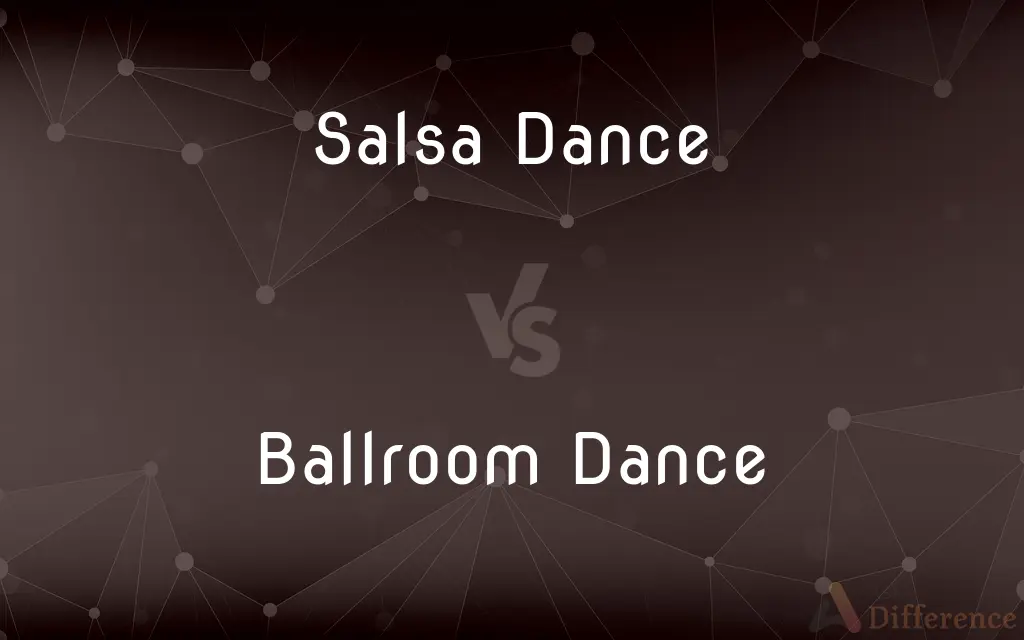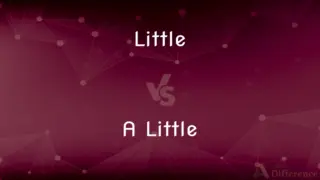Salsa Dance vs. Ballroom Dance — What's the Difference?
By Tayyaba Rehman — Published on December 15, 2023
Salsa Dance is a Latin dance originating from Cuba with Afro-Cuban rhythms, while Ballroom Dance is a set of partner dances enjoyed socially and competitively worldwide.

Difference Between Salsa Dance and Ballroom Dance
Table of Contents
ADVERTISEMENT
Key Differences
Salsa Dance, with its origins in the Caribbean, specifically in Cuba, is an expressive dance form that combines African and Spanish elements. Ballroom Dance, in contrast, is a Western dance form encompassing a range of styles, often performed in formal settings.
The rhythm and beat of Salsa Dance are derived from Afro-Cuban traditions, resulting in fast-paced and lively movements. Ballroom Dance, while varying in tempo, is often seen as more structured and elegant, with dancers maintaining a closed hold.
Salsa Dance is typically danced to specific salsa music, which emphasizes a quick-quick-slow rhythm. Ballroom Dance, on the other hand, can be danced to a variety of music genres depending on the specific dance, such as waltz, tango, or cha-cha.
Footwork is crucial in Salsa Dance, with many intricate steps and quick turns. Ballroom Dance places a strong emphasis on posture, poise, and the connection between the two partners.
While both Salsa Dance and Ballroom Dance are social dances that involve pairs, Salsa has a more informal, club-like atmosphere. Ballroom Dance, however, is often associated with formal events, competitions, and ballrooms.
ADVERTISEMENT
Comparison Chart
Origin
Cuba
Western countries
Music Type
Salsa music with quick-quick-slow rhythm
Various, depending on dance style
Dance Hold
Open and close hold variations
Predominantly closed hold
Atmosphere
Informal, club-like
Formal, competitive
Key Elements
Intricate footwork and turns
Poise, posture, partner connection
Compare with Definitions
Salsa Dance
A Latin dance form rooted in Afro-Cuban traditions.
She was captivated by the energy of the Salsa Dance.
Ballroom Dance
A structured partner dance emphasizing poise and elegance.
The couple gracefully glided across the floor during their Ballroom Dance.
Salsa Dance
Typically danced to salsa music with a distinct beat.
The pulsating beats made everyone eager to try the Salsa Dance.
Ballroom Dance
A Western dance form with various styles like waltz and tango.
She wore a flowing gown for her Ballroom Dance performance.
Salsa Dance
A social dance known for its quick footwork.
They took Salsa Dance lessons for their upcoming trip to Havana.
Ballroom Dance
Often associated with formal events and competitions.
They won first place in the national Ballroom Dance championship.
Salsa Dance
Characterized by its quick-quick-slow rhythm.
The rhythm of the Salsa Dance was infectious and invigorating.
Ballroom Dance
Encompasses both Standard and Latin styles.
He specialized in the Latin category of Ballroom Dance.
Salsa Dance
Often danced in an open or close hold.
The couple showcased their Salsa Dance skills at the club.
Ballroom Dance
Primarily danced in a closed hold position.
Their connection in the Ballroom Dance was impeccable.
Common Curiosities
Is Salsa Dance always fast-paced?
While Salsa Dance is often lively, its pace can vary depending on the music and style.
Which dance form emphasizes intricate footwork more?
Salsa Dance is especially known for its intricate footwork and quick turns.
What is the origin of Salsa Dance?
Salsa Dance originated in Cuba, combining African and Spanish elements.
Is Ballroom Dance only for formal occasions?
While often associated with formality, Ballroom Dance can be enjoyed casually as well.
Is Salsa Dance a type of Ballroom Dance?
While salsa is a partner dance, it's distinct from traditional Ballroom Dance styles but is included in some Ballroom Dance competitions under the Latin category.
Is Salsa Dance only performed to salsa music?
Typically, yes. Salsa Dance is danced to salsa music that has a distinct rhythm.
Can you name some Ballroom Dance styles?
Ballroom Dance includes styles like the waltz, tango, foxtrot, and cha-cha.
Which dance is more informal in nature?
Salsa Dance generally has a more informal, club-like atmosphere compared to Ballroom Dance.
Which dance form places more emphasis on posture?
Ballroom Dance places a strong emphasis on posture, poise, and partner connection.
Which dance is more widespread globally?
While both are popular, Ballroom Dance has a longer history and is widespread in many countries.
Do both dances have health benefits?
Yes, both Salsa Dance and Ballroom Dance offer cardiovascular benefits, improved coordination, and mental well-being.
Do both dance forms require partners?
Yes, both Salsa Dance and Ballroom Dance are typically danced in pairs.
Are there competitions for Salsa Dance?
Yes, there are various Salsa Dance competitions held globally.
Can Ballroom Dance be danced to modern music?
Depending on the dance style, many Ballroom Dances can adapt to modern tunes.
Can beginners learn both Salsa Dance and Ballroom Dance?
Absolutely, beginners can start with foundational steps in both dance forms.
Share Your Discovery

Previous Comparison
Little vs. A Little
Next Comparison
Taq Polymerase vs. DNA PolymeraseAuthor Spotlight
Written by
Tayyaba RehmanTayyaba Rehman is a distinguished writer, currently serving as a primary contributor to askdifference.com. As a researcher in semantics and etymology, Tayyaba's passion for the complexity of languages and their distinctions has found a perfect home on the platform. Tayyaba delves into the intricacies of language, distinguishing between commonly confused words and phrases, thereby providing clarity for readers worldwide.












































